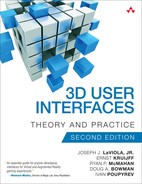PREFACE TO THE FIRST EDITION
An architect sits in her home office, putting the final touches on the design of the new entrance to the city park. A three-dimensional virtual model of the park appears in front of her on the desk’s surface. She nudges a pathway slightly to the right to avoid a low-lying area, and then makes the model life-size so she can walk along the path to view the effect. “Those dark colors on the sign at the entrance are too foreboding,” she thinks, so she quickly changes the color palette to brighter primary colors. She looks up and notices that the clients are arriving for the final design review meeting. They are located in other offices around the city, but they can all view the 3D model and make suggested changes, as well as communicate with one another. “What’s the construction plan?” asks one of the clients. The architect starts an animation showing the progress of the project from start to finish. “That first step may not work,” says the client. “The excavation is much too close to the existing playground. Let me show you.” He looks out his window, which has a view of the park, and overlays the virtual construction plan on it. “You’re right,” says the architect, “let’s plan to move the playground slightly—that will be much cheaper than changing the construction site.” After viewing the effects of the change, all agree that this plan will work, and the meeting adjourns.
This scenario and others like it illustrate the enormous potential of 3D environments and applications. The technology to realize such a vision is available now, although it will certainly be improved. But the scenario also leaves out a great deal of information—information that is crucial to making this dream a reality. How did the architect load the park model, and how does she manipulate her view of it? What technique is used to change the pathway? How can multiple clients all manipulate the model at the same time? How do the participants appear to each other in the virtual space? How is the speed and playback of the animation controlled? How did the client instruct the system to merge the real and virtual scenes?
These questions all relate to the design of the user interface (UI) and interaction techniques for this 3D application, an area that is usually given only a cursory treatment in futuristic films and books. The scenarios usually either assume that all interaction between the user and the system will be “natural”—based on techniques like intuitive gestures and speech—or “automatic”—the system will be so intelligent that it will deduce the user’s intentions. But is this type of interaction realistic, or even desirable?
This book addresses the critical area of 3D UI design—a field that seeks to answer detailed questions, like those above, that make the difference between a 3D system that is usable and efficient and one that causes user frustration, errors, and even physical discomfort. We present practical information for developers, the latest research results, easy-to-follow guidelines for the UI designer, and relevant application examples. Although there are quite a few books devoted to UIs in general and to 2D UI design in particular, 3D UIs have received significantly less attention. The results of work in the field are scattered throughout numerous conference proceedings, journal articles, single book chapters, and Web sites. This field deserves a reference and educational text that integrates the best practices and state-of-the-art research, and that’s why this book was created.
How This Book Came to Be
The story of this book begins in April 1998, when Ivan Poupyrev and Doug Bowman were doctoral students at Hiroshima University and Georgia Tech, respectively, working on 3D interaction techniques for object manipulation in virtual environments (VEs). We started a lively email discussion about the design and usability of these techniques and about 3D UIs in general. Ivan, who was at the time a visiting research student at the University of Washington, suggested that the discussion would be even more profitable if other researchers in this new area could join in as well, and so the 3D UI mailing list was born. Since that time, over 100 researchers from around the globe have joined the list and participated in the discussion (to see an archive of all the list traffic or to join the list, check out http://www.3dui.org). Joe LaViola and Ernst Kruijff were two of the first people to join the list.
In August of that same year, Doug forwarded to the list a call for tutorials for the upcoming IEEE Virtual Reality Conference. After some discussion, Joe, Ivan, and Ernst agreed to join Doug to organize a tutorial on “The Art and Science of 3D Interaction.” The tutorial was a big hit at the conference in Houston, and the four of us continued to present courses on the topic at ACM Virtual Reality Software and Technology 1999, IEEE VR 2000, and ACM SIGGRAPH 2000 and 2001.
After developing a huge amount of content for the notes supplements of these courses, we decided it would be silly not to compile and expand all of this information in book form. Furthermore, there was no way to include all the information available on 3D UIs in a one-day course. And that’s why you’re holding this book in your hands today—a book containing information on 3D UIs that can’t be found in any other single source.
